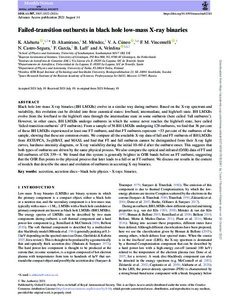Failed-transition outbursts in black hole low-mass X-ray binaries
Veledina A.; Vincentelli F. M.; Alabarta K.; Méndez M.; García F.; Cúneo V. A.; Luff B.; Castro-Segura N.; Altamirano D.
https://urn.fi/URN:NBN:fi-fe2021102752681
Tiivistelmä
Black hole low-mass X-ray binaries (BH LMXBs) evolve in a similar way during outburst. Based on the X-ray spectrum and variability, this evolution can be divided into three canonical states: low/hard, intermediate, and high/soft state. BH LMXBs evolve from the low/hard to the high/soft state through the intermediate state in some outbursts (here called 'full outbursts'). However, in other cases, BH LMXBs undergo outbursts in which the source never reaches the high/soft state, here called 'failed-transition outbursts' (FT outbursts). From a sample of 56 BH LMXBs undergoing 128 outbursts, we find that 36 per cent of these BH LMXBs experienced at least one FT outburst, and that FT outbursts represent ~33 per cent of the outbursts of the sample, showing that these are common events. We compare all the available X-ray data of full and FT outbursts of BH LMXBs from RXTE/PCA, Swift/BAT, and MAXI, and find that FT and full outbursts cannot be distinguished from their X-ray light curves, hardness-intensity diagrams, or X-ray variability during the initial 10-60 d after the outburst onset. This suggests that both types of outbursts are driven by the same physical process. We also compare the optical and infrared (O/IR) data of FT and full outbursts of GX 339-4. We found that this system is generally brighter in O/IR bands before an FT outburst, suggesting that the O/IR flux points to the physical process that later leads to a full or an FT outburst. We discuss our results in the context of models that describe the onset and evolution of outbursts in accreting X-ray binaries.
Kokoelmat
- Rinnakkaistallenteet [19207]
